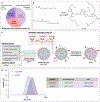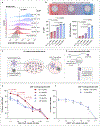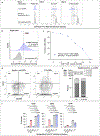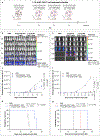Antigen Presenting Cell Mimetic Lipid Nanoparticles for Rapid mRNA CAR T Cell Cancer Immunotherapy
- PMID: 38419362
- PMCID: PMC11209815
- DOI: 10.1002/adma.202313226
Antigen Presenting Cell Mimetic Lipid Nanoparticles for Rapid mRNA CAR T Cell Cancer Immunotherapy
Abstract
Chimeric antigen receptor (CAR) T cell therapy has achieved remarkable clinical success in the treatment of hematological malignancies. However, producing these bespoke cancer-killing cells is a complicated ex vivo process involving leukapheresis, artificial T cell activation, and CAR construct introduction. The activation step requires the engagement of CD3/TCR and CD28 and is vital for T cell transfection and differentiation. Though antigen-presenting cells (APCs) facilitate activation in vivo, ex vivo activation relies on antibodies against CD3 and CD28 conjugated to magnetic beads. While effective, this artificial activation adds to the complexity of CAR T cell production as the beads must be removed prior to clinical implementation. To overcome this challenge, this work develops activating lipid nanoparticles (aLNPs) that mimic APCs to combine the activation of magnetic beads and the transfection capabilities of LNPs. It is shown that aLNPs enable one-step activation and transfection of primary human T cells with the resulting mRNA CAR T cells reducing tumor burden in a murine xenograft model, validating aLNPs as a promising platform for the rapid production of mRNA CAR T cells.
Keywords: CAR T cells; biomimicry; cancer immunotherapy; lipid nanoparticles; mRNA.
© 2024 The Authors. Advanced Materials published by Wiley‐VCH GmbH.
Conflict of interest statement
Conflicts of Interest
A.E.M., M.M.B., and M.J.M. are inventors on a patent filed by the Trustees of the University of Pennsylvania (US Provisional Patent Application No. 63/378,819, filed October 7, 2022; PCT International Patent Application No. PCT/US23/76231, filed October 6, 2023) describing the CD3/CD28 antibody fragment conjugated lipid nanoparticle technology described in this work. N.C.S. holds equity in Tmunity Therapeutics and is an advisor to Tome Biosciences. All other authors declare they have no competing interests.
Figures






References
-
- FDA Approval Brings First Gene Therapy to the United States, FDA, 2020.
-
- FDA Approves CAR-T Cell Therapy to Treat Adults with Certain Types of Large B-Cell Lymphoma, FDA, 2020.
-
- FDA Approves First Cell-Based Gene Therapy For Adult Patients with Relapsed or Refractory MCL, FDA, 2020.
-
- FDA D.I.S.C.O. Burst Edition: FDA Approval of Breyanzi (Lisocabtagene Maraleucel) for Second-Line Treatment of Large B-Cell Lymphoma, FDA, 2022.
-
- FDA D.I.S.C.O. Burst Edition: FDA Approval of ABECMA (Idecabtagene Vicleucel) the First FDA Approved Cell-Based Gene Therapy for the Treatment of Adult Patients with Relapsed or Refractory Multiple Myeloma, FDA, 2021.
MeSH terms
Substances
Grants and funding
- R01 DK123049/DK/NIDDK NIH HHS/United States
- RSG-22-122-01-ET/American Cancer Society Research Scholar Grant
- T90 DE030854/DE/NIDCR NIH HHS/United States
- P30 AI045008/AI/NIAID NIH HHS/United States
- DP2 TR002776/TR/NCATS NIH HHS/United States
- University of Pennsylvania Fontaine Fellowship
- F31 CA260922/CA/NCI NIH HHS/United States
- R01 CA241661/CA/NCI NIH HHS/United States
- R37 CA244911/CA/NCI NIH HHS/United States
- Robert Wood Johnson Foundation Health Policy Research Scholars Program
- CBET-2145491/US National Science Foundation CAREER award
- Norman and Selma Kron Research Fellowship
- Burroughs Wellcome Fund Career Award at the Scientific Interface (CASI)
- T90DE030854/National Institute of Dental and Craniofacial Research of the US National Institutes of Health
- Emerson Collective
- P30 CA016520/CA/NCI NIH HHS/United States
- US National Science Foundation Graduate Research Fellowship
- F31CA260922/US National Institutes of Health Ruth L. Kirschstein National Research Service Award
LinkOut - more resources
Full Text Sources
Other Literature Sources
Miscellaneous

